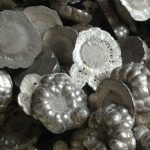Notice: Undefined index: sith_hide_share in /www/sites/alloy.wiki/index/wp-content/themes/likegoogle/single.php on line 32
Deprecated: get_settings is deprecated since version 2.1.0! Use get_option() instead. in /www/sites/alloy.wiki/index/wp-includes/functions.php on line 4862
BT22 titanium alloy bar has a nominal composition of Ti-5Al-5Mo-5V-1Cr-1Fe, which is a high-strength and high-toughness titanium alloy. The outstanding advantage of the alloy is that it has a very high strength level (1080MPa) in the annealed state, and the strength can reach 1300MPa after intensified heat treatment. And the hardenability is excellent, the cross-section hardened thickness can reach 250mm, because the cross-section thickness is not limited by the hardenability, it is especially suitable for manufacturing large-scale load-bearing members of the aircraft. This is also the most prominent advantage of TC18 titanium alloy, which can use ordinary low cost A variety of processes, such as die forging (on a die forging hammer), hot die forging, and isothermal die forging, produce forgings close to the final shape. The alloy has been widely used in aircraft such as the Il-76.

Researchers have made BT22 titanium alloy ingots through β-zone blooming, and then used three different forging processes to obtain Ф400mm bars. After the same heat treatment was performed on the obtained bars, the results of microstructure and mechanical properties were compared. Through analysis and research, the ideal forging process of BT22 titanium alloy large-size bar was obtained.
The test uses three Φ804mm smelted ingots with a vacuum consumable arc furnace and an ingot weight of 4000 kg. The (α + β) / β phase transition temperature is 860 to 870 ° C.
The ingot is heated in the β zone, and is opened by forging with a hydraulic press, and then different forging processes are used. After multiple fires, the forging is heated and forged in the single-phase zone or the α + β zone, and the final forging is a Ф400mm bar. The obtained rods were sampled after the same heat treatment for microstructure and performance testing. The detailed process plan is as follows:
Process 1: Opening + high-low-high + 30% two-phase zone deformation;
Technology 2: Opening + high and low + 70% ~ 85% deformation in the two-phase area;
Process three: Opening + high and low, water quenching + 70% to 85% of the two-phase zone deformation.
Research indicates:
(1) Compared with the other two process schemes, the microstructure of the Ф400mm bar obtained by the third process (opening + high-low-high, water-quenching + 70% -85% two-phase zone deformation forging process) is compared with the other two process schemes, and the microstructure is uniform and fine. The degree of transformation is better than other schemes.
(2) The strength index obtained by using process three (opening + high-low-high, water-quenching + 70% to 85% two-phase zone deformation forging process) of the Ф400mm bar due to the influence of the fine grain strengthening mechanism, while ensuring the plasticity index highest. In addition, due to the fine and uniform grains obtained in the third process, the crack propagation path increases, which significantly increases the fracture toughness index obtained by the process, and the best overall performance.
Guest contributors are welcome at the Alloy Wiki.It is a weekly wiki and guide on alloy information and processing technology, while also about the vast array of opportunities that are present in manufacturing. Our team of writers consists of a Machining Material Supplier / Machinist / Tool and Die Maker, a Biomedical Engineer / Product Development Engineer, a Job Development Coordinator / Adjunct Professor, and a President and CEO of a manufacturing facility.
Link to this article:Research on Forging Process of BT22 Large Bar
Reprint Statement: If there are no special instructions, all articles on this site are original. Please indicate the source for reprinting:Alloy Wiki,thanks!^^


